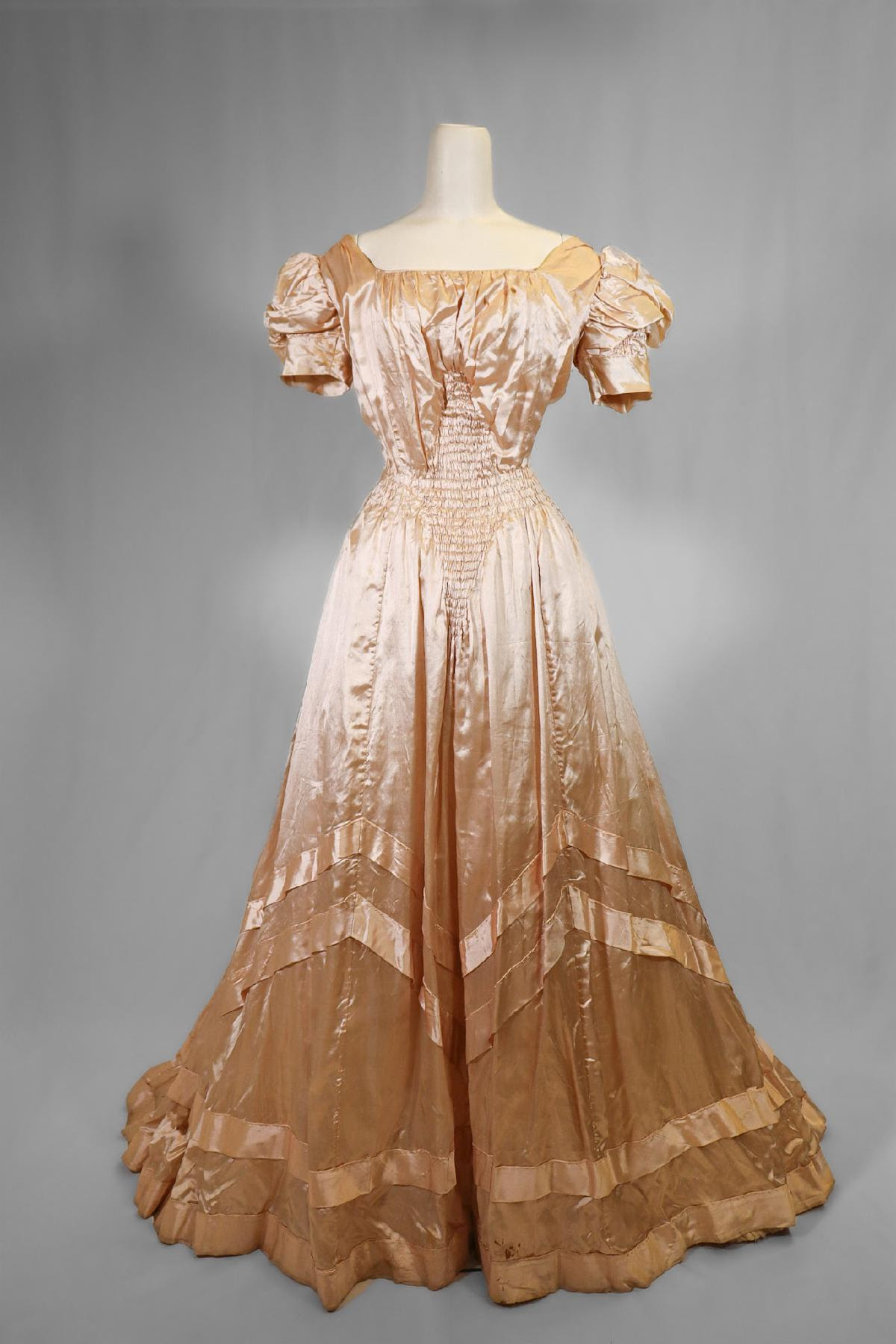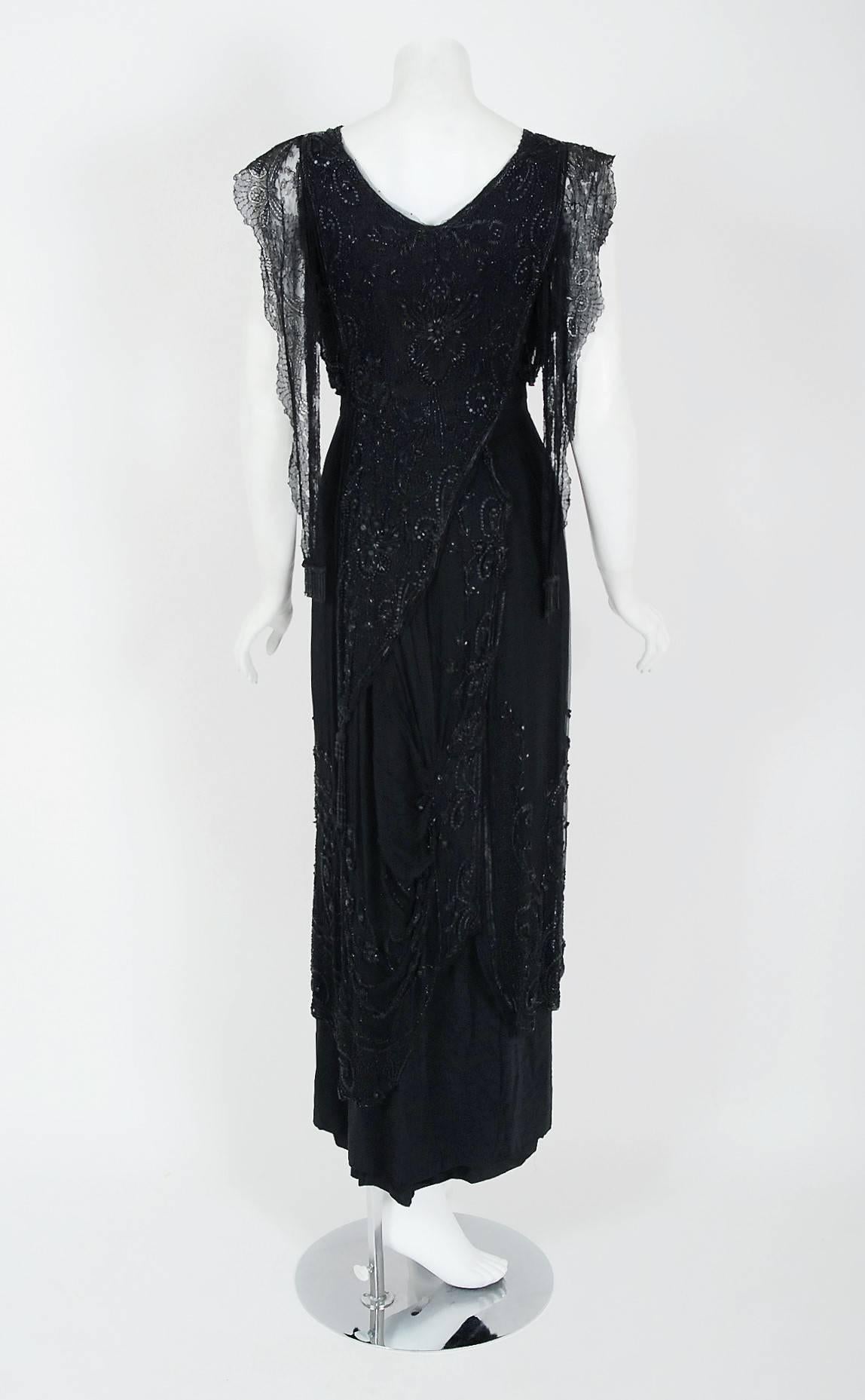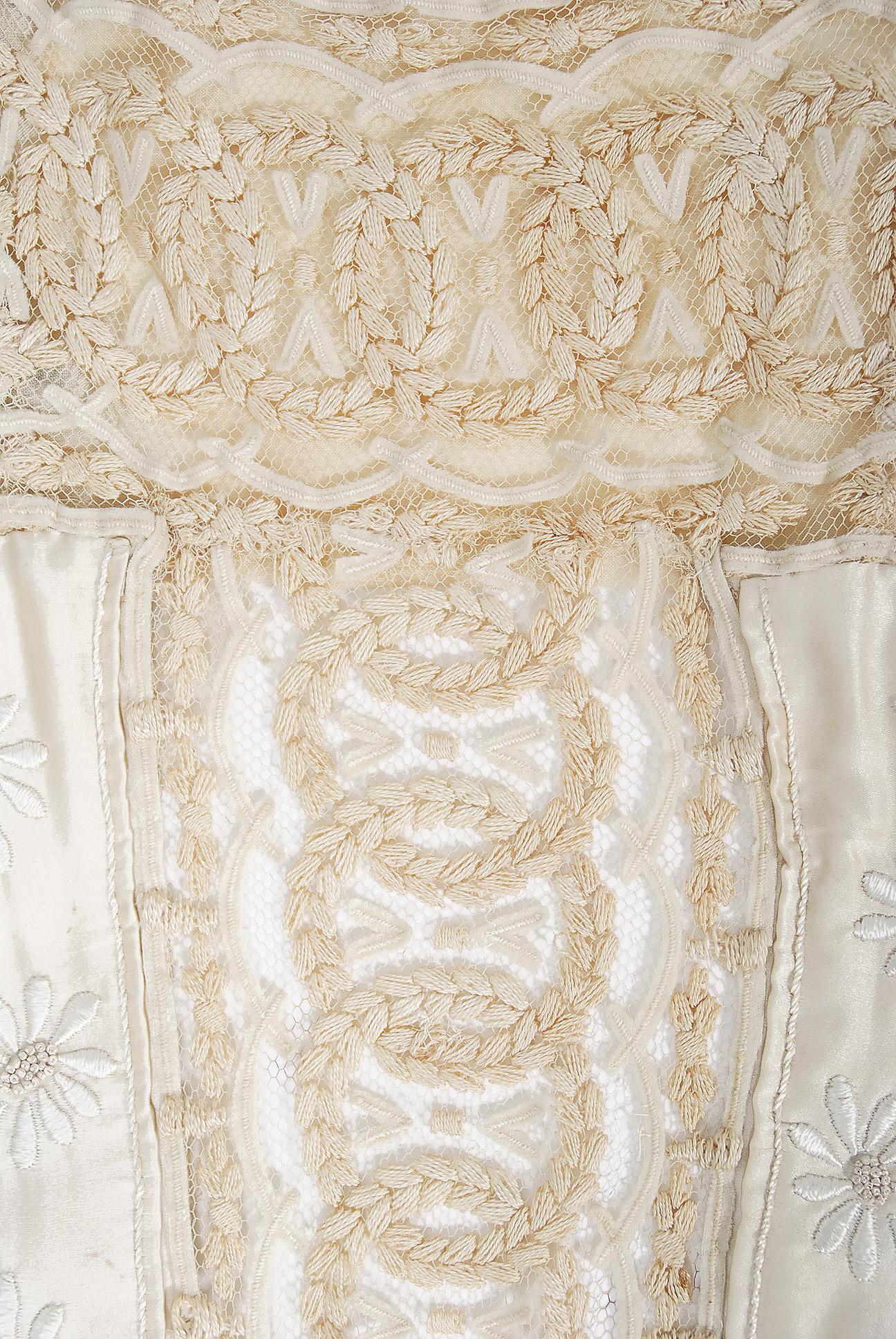1910s Evening Gown - A Look At Edwardian Glamour
Imagine a time when getting ready for an evening out was a truly grand affair, a moment of real anticipation and beauty. We are talking about the early 1900s, a period that saw evening wear reach some pretty remarkable heights. Think about the gowns worn by those who traveled on grand ocean liners, or attended fancy dinners; these weren't just clothes, they were statements, full of grace and a certain kind of quiet splendor, you know?
This was a time when a dress for a formal night could feel a bit like a work of art, with fabrics that moved just so and details that caught the eye. The line between a ball gown and a general evening dress was often, well, kind of blurry, allowing for a lovely flow in what was considered appropriate. People really put thought into how they would present themselves, making sure every part of their look spoke of the occasion, in a way.
So, if you've ever wondered about the kind of outfits that graced those elegant gatherings, the ones that perhaps boarded a famous ship, or simply made an appearance at a special dinner, you're in for a treat. We are going to explore what made these 1910s evening gowns so distinctive, where you might still catch a glimpse of them, and what went into making them so, very special, as a matter of fact.
Table of Contents
- What Made a 1910s Evening Gown Special?
- Where Can We See 1910s Evening Gowns Today?
- Creating Your Own 1910s Evening Gown
What Made a 1910s Evening Gown Special?
When you think about the early 1900s, especially the years around 1910, the clothing for evening events had a certain charm. These outfits were crafted to make an impression, to really stand out in a gentle, refined way. A 1910s evening gown was typically a long, flowing garment, often with a rather elegant shape that moved with the wearer. It wasn't about being overly restrictive, but more about a graceful drape. The overall look aimed for a kind of soft, elongated figure, which was quite popular at the time, you know, for ladies going out to dinner or a dance. They really were quite something to behold, actually.
The Look and Feel of a 1910s Evening Gown
The general shape for an evening dress from this period had a distinct flow. It wasn't about a tight, constricting outline, but rather something that allowed for movement and a soft silhouette. These dresses were often made from materials that felt light and airy, like fine silks or chiffons, which would just float around the person wearing them. Imagine a dress that seems to drift as you walk, with a subtle shimmer. That was often the idea, really. The way these dresses were put together made them feel quite luxurious, with a focus on the way the fabric draped and moved, kind of like a second skin, but much more grand.
We've come across examples, like a ball gown or evening dress from around 1902, which shows just how fluid the distinction between these two dress types could be. Sometimes, it was just a matter of how formal the event was, or perhaps the specific embellishments. These dresses often had a gentle sweep to them, a long, lean line that was considered very fashionable. They weren't stiff, but had a natural elegance that came from the cut and the way the fabric behaved, pretty much. It was all about creating a sense of ease and beauty.
What About the Neckline of a 1910s Evening Gown?
For formal evening wear during the Edwardian period and into the 1910s, there was a very common feature: a low, open neckline. This was pretty much the standard for women's dresses when they were going out for a fancy night. Unless a woman was very old, this type of neckline was expected. It was part of the style of the day, a way to show a bit of skin in a refined manner. This design choice was consistent with how these dresses were generally put together, fitting in with the overall fashion sense of the time. It was a detail that really defined the look of a 1910s evening gown, you know, making it instantly recognizable as formal attire for that era.
This style of neckline wasn't just a random choice; it was a defining characteristic. It gave the dresses a certain air of sophistication and openness, which was a big part of the fashion trends back then. So, if you were to see a picture of an evening dress from, say, 1912, it would almost certainly have this kind of neckline. It was just what people wore for these special occasions, a kind of unspoken rule of dressing up. It really shows how certain elements of fashion can become incredibly popular and widely adopted, pretty much becoming a signature look for a whole decade.
Where Can We See 1910s Evening Gowns Today?
If you're curious to see these beautiful creations up close, there are places where they are kept and cared for. Museums, for example, often have collections that include dresses from this time. These institutions do a wonderful job of preserving fashion history, allowing us to get a real sense of what people wore and how they dressed for special events. It's a way to step back in time and appreciate the craftsmanship and design of a 1910s evening gown. They're like little time capsules, offering glimpses into a bygone era, and that's pretty neat, honestly.
Museum Pieces and Historic Finds
Collections like the one at The Metropolitan Museum of Art, or the Brooklyn Museum costume collection, hold some truly remarkable examples. You can find dresses there that show the common characteristics of evening wear from the 1910s. These pieces are often incredibly well-preserved, letting you see the delicate fabrics and the intricate details that went into them. It's not always easy to find a lot of information about every single piece, but what is available certainly paints a picture of elegance and style. For instance, a 1910s evening dress made of silk chiffon, with sequins and beads, is part of the Palais Galliera collection, which gives you a sense of the materials and decorations used, just like that.
Sometimes, you might even come across pieces that were custom-made or unique, showing the personal flair of the wearer or the designer. There are also resources like 1stdibs, which is a premier place for vintage fashion, where you might find 1910s evening dresses and gowns from top boutiques around the world. These pieces offer a tangible connection to the past, allowing us to appreciate the artistry involved in creating such garments. It's really quite fascinating to see how fashion has evolved, and these dresses are a wonderful part of that story, in a way.
How Did the Titanic Influence 1910s Evening Gown Style?
The Titanic, which set sail in April 1912, offers a poignant glimpse into the fashion of the early 1910s. Her first-class passengers boarded with trunks absolutely full of expensive, beautiful clothes, including, of course, their evening wear. The dresses worn for dinner on the Titanic would have been prime examples of the 1910s evening dress style. This period was known for its graceful shapes and luxurious materials, and the gowns on board would have reflected this perfectly. It really puts into perspective the kind of formal attire that was expected for such a grand voyage, basically.
You can even find inspiration from this era in things like "Titanic tea dress" selections, which, while not always actual evening gowns, certainly capture the spirit of the period. The dresses would have been made to conform to the common details of evening dresses from that specific time, showing the prevailing tastes. Imagine the rustle of silk and the sparkle of beads as people moved through the ship's dining rooms. It was a time when dressing for dinner was a significant event in itself, and the clothing reflected that importance. The sheer opulence of these gowns, often adorned with beads, lace, or other trimmings, really speaks volumes about the fashion sensibilities of the time, to be honest.
Creating Your Own 1910s Evening Gown
If you're someone who loves historical fashion, or just enjoys the idea of making something beautiful, recreating a 1910s evening gown can be a rewarding project. There are patterns available that are based on original designs from that period. This means you can get a pretty authentic feel for the style. What's cool is that these patterns can often be adapted in various ways, so you don't have to worry about looking exactly like everyone else. You can add your own touches while staying true to the era's aesthetic, which is kind of fun, right?
You might consider using materials that echo the original garments, like a magenta silk sari with gold woven detail, or purple silk charmeuse and cream chiffon, perhaps with some crystal beads. These choices would certainly give your creation an authentic feel, like the 1914 evening or ball dress that was made from such materials. It's about bringing that historical vision to life with your own hands, and that's a pretty special thing to do, if you ask me.
The Fabrics and Details of a 1910s Evening Gown
Evening dresses of the 1910s were truly special because of the materials they used. They were often crafted from delicate, sheer fabrics. Think about how light and airy chiffon feels, or the smooth touch of silk. These fabrics were frequently embellished with beads, lace, or other decorative trimmings. These additions weren't just sewn on; they were often designed to float over a silk underlayer, giving the dress a wonderful sense of movement and depth. It created a layered effect that was both luxurious and ethereal, giving the wearer a very graceful appearance, sort of like a dream, actually.
Satin, in its many forms, was also a popular choice for these gowns. Its smooth, lustrous surface added to the richness of the garment. Unlike some tailored suits of the era, where there seemed to be a bit of a shortage of material, evening gowns had plenty of fabric to create their flowing lines. This generous use of material allowed for beautiful drapes and folds, which were a hallmark of the style. You might see a blue evening dress with elegant cape sleeves, or a 1912 lavender silk beaded gown, showing the variety in color and design. The peacock, symbolizing beauty and exoticism, was also a favored design motif around 1910, sometimes appearing on these stunning pieces, which is kind of cool, really.
A Nod to Gentlemen's Evening Wear
While we're talking about evening wear, it's worth a moment to consider what the gentlemen wore. Their formal evening dress during this period was actually quite similar to what we might see today. Typically, it involved a black tail coat or a tuxedo jacket. So, if you were picturing a couple dressed for a formal dinner in 1910, the gentleman's attire would look surprisingly familiar. This consistency in men's formal wear is pretty interesting when you compare it to the more dramatic shifts in women's fashion over the decades. It just goes to show how some styles have a remarkable staying power, more or less.
You can find ideas for 1910s fashion, including women's evening gowns, on platforms like Pinterest, which can be a great visual resource. And if you're looking for vintage-inspired pieces, there are options for new 1910s evening dresses, like 1912 Titanic dinner gowns or 1918 party dresses. These modern interpretations often capture the spirit of the original designs, allowing people to experience a touch of that historical elegance today. It's a fun way to connect with the past, and really appreciate the timeless appeal of these beautiful clothes, you know?
So, we've explored the charm and details of 1910s evening gowns, from their signature necklines and flowing silhouettes to the luxurious fabrics and embellishments that made them so special. We've seen how these dresses were part of significant historical moments, like the voyages of the Titanic, and how museums continue to preserve their beauty. We also touched upon how these styles can inspire modern creations and even noted the enduring nature of gentlemen's formal wear from that period. It's clear that the 1910s left us with a truly beautiful legacy in evening fashion.

Clothing and Textiles: Blush Pink Evening Gown C. Early 1900s - New

1910's Edwardian Couture Black Beaded Silk and Lace Art-Nouveau Evening

1910's Ivory Crème Embroidered Sheer Net-Lace and Silk Satin Trained